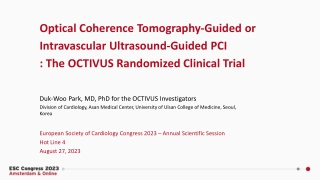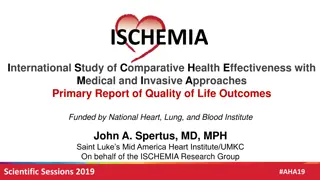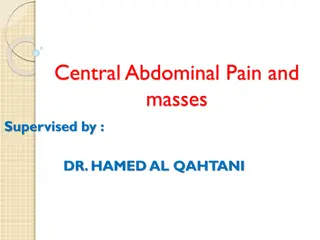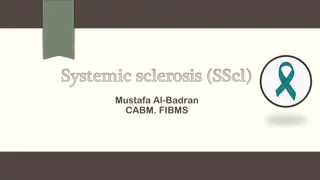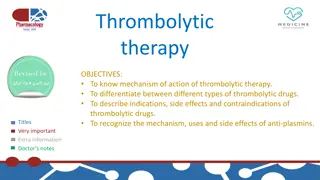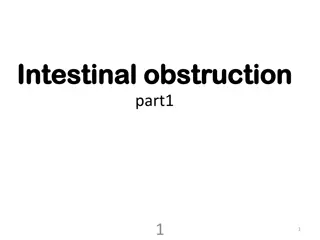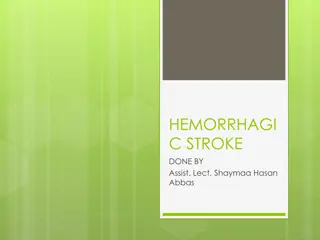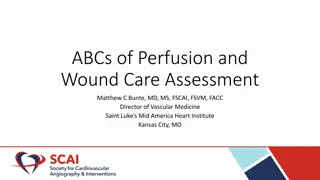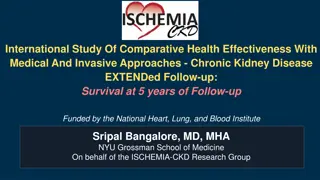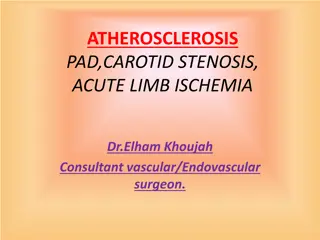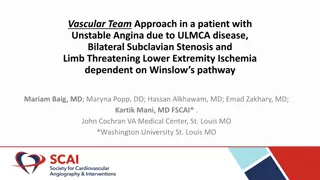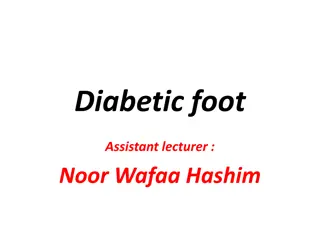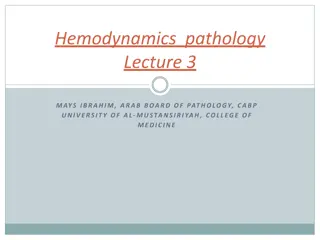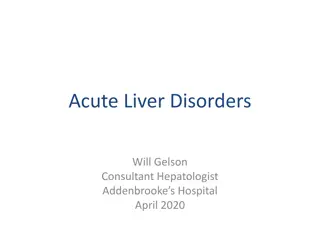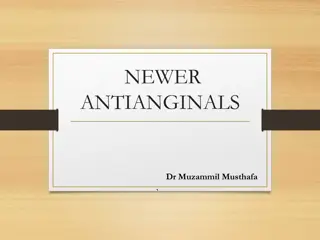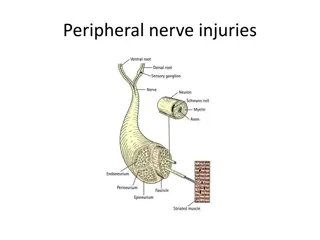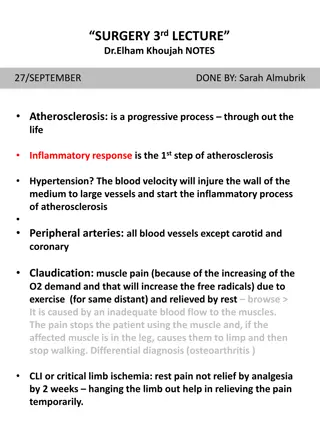OCTIVUS Randomized Clinical Trial: OCT-Guided vs IVUS-Guided PCI
The OCTIVUS Randomized Clinical Trial compared the clinical efficacy and safety of Optical Coherence Tomography (OCT)-guided and Intravascular Ultrasound (IVUS)-guided strategies in patients undergoing PCI for significant CAD. The study aimed to determine if OCT-guided PCI is noninferior to IVUS-gui
8 views • 27 slides
Comparative Health Effectiveness Study: Quality of Life Outcomes with Medical and Invasive Approaches
This primary report funded by the National Heart, Lung, and Blood Institute presents the International Study of Comparative Health Effectiveness with Medical and Invasive Approaches. The research evaluates whether an invasive strategy improves health status in stable patients with moderate ischemia,
1 views • 21 slides
Understanding Central Abdominal Pain and Masses in Clinical Practice
Abdominal pain evaluation involves considering various differential diagnoses such as appendicitis, small bowel obstruction, and mesenteric ischemia. By categorizing pain as visceral, parietal, referred, or radiating, healthcare providers can better understand the underlying pathology. The history o
0 views • 57 slides
Understanding Systemic Sclerosis: Causes, Symptoms, and Management
Systemic sclerosis (SScl) is an autoimmune disorder affecting connective tissue, leading to fibrosis in the skin, internal organs, and vasculature. It is characterized by Raynaud's phenomenon, digital ischemia, sclerodactyly, and cardiac, lung, gut, and renal involvement. Peak onset is in the fourth
1 views • 28 slides
Understanding Thrombolytic Therapy and Plasminogen Activation
Thrombolytic therapy involves the use of drugs to dissolve blood clots, with plasminogen activation being a key mechanism. Different types of thrombolytic drugs like fibrin-specific and non-fibrin-specific agents are available, each with varying effects on clot dissolution and systemic plasminogen a
1 views • 13 slides
Understanding Intestinal Obstruction: Causes, Classification, and Pathophysiology
Intestinal obstruction can be classified into dynamic and adynamic types, with various causes such as intraluminal faecal impaction, malignancy, and hernia. The pathophysiology involves changes in bowel peristalsis and dilation, leading to potential strangulation and ischemia. Morbidity and mortalit
9 views • 40 slides
Understanding Chronic Coronary Syndrome: Causes, Symptoms, and Management
Chronic coronary syndrome involves a dynamic process of atherosclerotic plaque accumulation and functional alterations in coronary circulation. It includes various clinical scenarios such as stable angina, asymptomatic ischemia, prior myocardial infarction, and more. The condition can be modified by
0 views • 131 slides
Treatment Strategies for Hemorrhagic Stroke: Goals and Management
Short-term goals for treating hemorrhagic stroke involve rapid neurointensive care to maintain adequate oxygenation, breathing, and circulation, along with managing increased intracranial pressure and blood pressure. Long-term management focuses on preventing complications, recurrent bleeding, delay
11 views • 9 slides
Understanding Perfusion and Wound Care Assessment
This comprehensive presentation delves into the critical aspects of perfusion and wound care assessment, covering topics such as tissue oxygenation, measuring tissue perfusion, diagnostic testing for critical limb ischemia, and techniques like ankle and toe systolic pressure measurement and transcut
0 views • 19 slides
Comparative Study on Health Effectiveness in Chronic Kidney Disease
Study focuses on the benefits of adding cardiac catheterization and revascularization to medical therapy in stable CKD patients with moderate ischemia. The ISCHEMIA-CKD trial compared invasive versus conservative treatment strategies, enrolling high-risk patients with various comorbidities. Results
2 views • 21 slides
Understanding Atherosclerosis, Peripheral Artery Disease, and Carotid Stenosis
This informative content details the histo-anatomy of blood vessels, pathophysiology of atherosclerosis, peripheral ischemia, and carotid artery disease. It covers the definition, risk factors, and processes involved in atherosclerosis, including endothelial cell function, blood flow dynamics, and f
3 views • 24 slides
Vascular Team Approach in Unstable Angina with Complex Vascular Disease
A 73-year-old patient with COPD, hypertension, and hyperlipidemia presents with severe lower extremity ischemia, leading to a plan for urgent aorto-bifemoral bypass. The clinical examination and test results revealed critical limb ischemia and extensive vascular disease requiring intervention from c
0 views • 19 slides
Understanding Diabetic Foot Ulcers: Causes, Types, and Treatment
Diabetic foot ulcers are a common complication among diabetic patients, leading to disability and hospital admissions. The ulcers can be caused by factors like neuropathy and ischemia. Identifying the types, such as neuropathic and ischemic ulcers, helps in determining appropriate treatment, which m
0 views • 12 slides
Understanding Hemodynamics Pathology: Causes and Consequences of Various Embolisms
Hemodynamics pathology lecture covers fat embolism, air embolism, amniotic fluid embolism, ischemia, and infarction. Each type of embolism has distinct causes and clinical features, leading to serious consequences. Understanding these conditions is crucial for proper management and prevention in med
0 views • 24 slides
Principles and Management of Acute Liver Disorders by Consultant Hepatologist
This presentation discusses the principles, causes, presentations, management, and prognosis of acute liver disorders, with a focus on insult to the normal liver leading to liver injury, inflammation, and necrosis. It covers causes such as drugs, viruses, ischemia, autoimmune conditions, Budd-Chiari
0 views • 16 slides
Understanding Acute Liver Disorders: Causes, Presentations, and Management
Acute liver disorders can have various causes such as drugs, viruses, ischemia, autoimmune conditions, and more. The presentations of acute liver disease can include abnormal liver tests, jaundice, liver impairment, and even liver failure. Management involves removing and treating the underlying cau
0 views • 16 slides
Understanding Newer Antianginals and Cardiomyocyte Metabolism
Chronic angina is a condition marked by impaired quality of life and decreased life expectancy, primarily due to myocardial ischemia. It is characterized by symptoms like tightness, heaviness, and pressure sensation, often located retrosternally. The pathophysiology involves a mismatch between oxyge
0 views • 73 slides
Understanding Peripheral Nerve Injuries and Pathological Classification
Peripheral nerves play a crucial role in transmitting motor and sensory impulses. Injuries to these nerves can result from various causes like ischemia, compression, traction, laceration, or burning, leading to a range of severity from transient dysfunction to complete interruptio...
0 views • 18 slides
Understanding Atherosclerosis and Peripheral Artery Diseases
Atherosclerosis is a progressive process triggered by an inflammatory response, often aggravated by hypertension. Conditions like claudication and critical limb ischemia are indications of inadequate blood flow, posing risks of rest pain and ischemic ulcers. Recognizing symptoms like pain, numbness,
0 views • 4 slides
